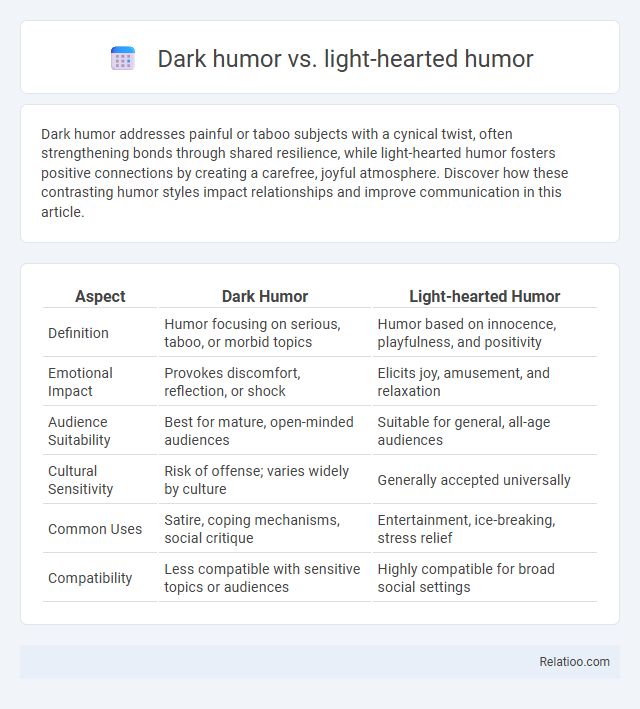Dark humor addresses painful or taboo subjects with a cynical twist, often strengthening bonds through shared resilience, while light-hearted humor fosters positive connections by creating a carefree, joyful atmosphere. Discover how these contrasting humor styles impact relationships and improve communication in this article.
Table of Comparison
| Aspect | Dark Humor | Light-hearted Humor |
|---|---|---|
| Definition | Humor focusing on serious, taboo, or morbid topics | Humor based on innocence, playfulness, and positivity |
| Emotional Impact | Provokes discomfort, reflection, or shock | Elicits joy, amusement, and relaxation |
| Audience Suitability | Best for mature, open-minded audiences | Suitable for general, all-age audiences |
| Cultural Sensitivity | Risk of offense; varies widely by culture | Generally accepted universally |
| Common Uses | Satire, coping mechanisms, social critique | Entertainment, ice-breaking, stress relief |
| Compatibility | Less compatible with sensitive topics or audiences | Highly compatible for broad social settings |
Understanding Dark Humor: Definition and Origins
Dark humor, also known as black comedy, employs morbid, taboo, or controversial topics to provoke laughter by highlighting the absurdity of serious or grim situations. Rooted in ancient literary traditions and gaining prominence in modern times through media and stand-up comedy, its origins trace back to works like Shakespeare's plays and Jonathan Swift's satirical writings. Understanding dark humor requires recognizing its function as a psychological coping mechanism and a tool for social commentary, contrasting with light-hearted humor's focus on playful, non-offensive amusement.
Light-Hearted Humor Explained: What Makes It Unique
Light-hearted humor is characterized by its gentle, playful nature that avoids offense and emphasizes positive emotions, making it widely accessible and socially safe. Unlike dark humor, which often tackles taboo or serious subjects with irony, and general humor, which can range broadly in tone, light-hearted humor uses innocent jokes, puns, and situational comedy to evoke laughter without discomfort. This style fosters inclusive social interactions, promotes relaxation, and enhances mood through its non-threatening and universally appealing content.
Psychological Effects: Dark Humor vs Light-Hearted Humor
Dark humor often helps individuals cope with stress and anxiety by reframing taboo or painful subjects, triggering complex emotional responses and fostering resilience. Light-hearted humor, characterized by its positive and non-threatening nature, promotes social bonding and reduces cortisol levels, enhancing overall mood and psychological well-being. Both forms impact mental health differently: dark humor is linked to increased cognitive processing and emotional catharsis, while light-hearted humor supports relaxation and optimism.
Cultural Perspectives on Different Humor Styles
Dark humor often explores taboo or serious subjects, resonating differently across cultures that vary in their tolerance for ambiguity and discomfort, while light-hearted humor, characterized by playful and non-offensive jokes, tends to be universally accepted and easier to share. Your appreciation of humor styles is deeply influenced by cultural norms, social values, and historical context, which shape what is considered funny or inappropriate in each society. Understanding these cultural perspectives helps you navigate humor in diverse social settings, enhancing communication and social bonding.
Social Acceptance: Where Each Humor Thrives
Dark humor thrives in social settings where taboo topics and discomfort can be approached with irony, often resonating in adult or niche groups that appreciate its subversive edge. Light-hearted humor dominates casual, family-friendly environments, promoting inclusivity and ease without risking offense, making it widely accepted across diverse social contexts. General humor adapts flexibly between these extremes, balancing relatability and appropriateness to maintain broad social acceptance and foster connection.
Risks and Boundaries in Dark Humor
Dark humor explores taboo and sensitive topics, often pushing societal boundaries, which increases the risk of offending or alienating audiences. Light-hearted humor relies on harmless, inclusive themes that promote positive social interactions without crossing ethical limits. Understanding these distinctions is vital for responsible use, as dark humor demands careful consideration of context, audience sensitivity, and cultural norms to avoid misinterpretation and potential harm.
Positivity and Inclusivity in Light-Hearted Humor
Light-hearted humor emphasizes positivity and inclusivity by fostering a supportive atmosphere that invites laughter without offending or alienating individuals. Unlike dark humor, which often explores taboo or sensitive topics, light-hearted humor promotes unity and shared joy through gentle, relatable content. Embracing laughter that uplifts participants enhances social connections and cultivates an environment where everyone feels valued and comfortable.
Popular Media Examples: Dark vs Light-Hearted Comedy
Dark humor often explores taboo or serious subjects with irony and satire, exemplified by TV shows like "South Park" and films such as "Dr. Strangelove," which use shock value to provoke thought. Light-hearted humor, found in sitcoms like "Friends" and movies like "The Princess Bride," relies on gentle, optimistic jokes that promote feel-good entertainment. Popular media leverages these humor styles to engage diverse audiences, with dark comedy appealing to those appreciating critical social commentary and light-hearted comedy catering to viewers seeking comfort and laughter without controversy.
Choosing the Right Humor for Your Audience
Choosing the right humor for your audience hinges on understanding their sensitivities and preferences, as dark humor often appeals to those comfortable with taboo or edgy topics, while light-hearted humor suits more general, uplifting interactions. Your ability to gauge the social context and the emotional climate will determine if humor should be subtle and inclusive or bold and provocative. Effective humor enhances engagement, fosters connection, and respects boundaries, making audience insight crucial for optimal comedic impact.
The Future of Humor in a Rapidly Changing World
Dark humor often tackles taboo or serious subjects with irony, while light-hearted humor relies on playful, innocent jokes that foster positivity and connection. Your engagement with humor is evolving as artificial intelligence and virtual realities create immersive comedic experiences tailored to individual preferences. The future of humor lies in blending diverse styles to reflect complex societal changes, enhancing relatability and emotional resilience in a rapidly changing world.

Infographic: Dark humor vs Light-hearted humor
 relatioo.com
relatioo.com